Last year I spent a week in Japan: a day in Tokyo, and 5 days in a country town by a ski resort 6 hours’ drive west of Tokyo. We were celebrating my 50th birthday and this was my celebration of choice – and what a super-fabulous choice it turned out to be!
When we first booked to come to Japan, I was under the illusion that Japan was the land of vegetarian food – the original plant-based diet. Was I ever wrong! Although plant-based 50 years ago, since WW2, things have turned around 180 degrees! Now all vegetarian choices, which used to predominate on menus – have been scrapped to show the nation’s recently acquired wealth.
This trip ended up being the biggest challenge I have yet had food-wise.
A Vegetarian in Tokyo
Eating plant based or even totally vegan in Tokyo was really very easy – if you bought food from the giant food halls in the basements of every department store and train station. These food meccas included so many beautiful salads, I could have stayed a week and never repeated any of them. Eggplant salads, cucumber and black sesame salads – the list was endless. You can also buy some good sour dough bread sticks in French style bakeries. Many curry stands also have some sort of curry made with beans, no doubt cooked in a meat stock though. I ate these takeaway meals in the only place to sit – in the roof top gardens under the smoggy sky.
You can spend fruitless hours reading menus outside Tokyo restaurants looking for one with vegetarian options. The answer is to select the ‘sides’ (grilled vegetables, salads, cooked potatoes, rice etc.) as main meals and entrees – they are quite substantial meals in themselves.
I quickly discovered that, in Japan, white rice was the only choice. I never saw brown rice once. As healthy civilisations have fuelled themselves on white rice for eons, I decided I would compromise and be thankful for it. It was that or starve, I think!
A Vegetarian in the Countryside
In rural Japan, people simply have no concept of being vegetarian. Who would avoid meat when they could afford it? To tell a Japanese person “Niku wa tabemasen” (I don’t eat meat) – is just saying you don’t eat RED meat, but you do eat pork, chicken, fish, horse, eggs, seafood, dairy, offal – all common foods there.
The vast majority of the rural Japanese restaurants are small family operations – they live upstairs, and downstairs is the small ‘restaurant’ in which they cook 6 – 12 related dishes.
Here’s the problem: they use pork stock or chicken stock, but not both; for vegetables they have cabbage or spinach, but not both; they offer pork meat or beef, but not both. As a delicacy, they may have raw horse meat sashimi, or a fried prawn or chicken dish (none of which looks anything like our versions). All are served with either soba (buckwheat) noodles or (white) rice, and often only one or the other. If you don’t want chicken stock and that’s what they serve, there is simply nothing else in their kitchen available – nothing at all. There is no chance that they can pull out a carton of vegetable stock from the pantry. Your option is to go hungry or to go next door to another restaurant – where you will find the exact same situation.
It took me ten minutes of discussing options in my limited Japanese on our first night in the country to discover this fact: that we were no longer in Australia where vegetarianism is well understood.
So what did I eat that first night when I was tired from a long flight and several long train rides and shuttle buses? I discovered cabbage salad – and did it taste amazing!!! Even with the suspect Italian dressing.
I also ate fried noodles with cabbage that first night. In Japan, ‘fried’ means ‘stir-fried’. As cabbage was the only vegetable in the restaurant, I convinced the chef to chop a cabbage and stir fry it with the noodles. (This was a feat in itself as I needed my phrase book to say everything). We all know how good those cabbages are for us!
Breakfast: The options were white rice, soy sauce, shallots with pickled turnips and radishes, miso soup with (many) vegetables, salad, fruit. They may be a meat-rich society now, but the Japanese still eat vegetables in large quantities for all 3 meals of the day.
I ate more vegetables in Japan than I would in my normal vegan week back home.
There is a total lack of soy milk. I asked for tounyuu over and over, until in one cafe, they explained that no one uses it anymore in Japan – they all drink cow’s milk now.
Always available was green tea, black tea or brown tea (roasted green tea).
A Vegetarian on the Ski Slopes
We went to Japan to ski, and I was anxious at how we would cope with the limited choices once on the slopes. I need not have feared – these ski slopes had literally dozens of full restaurants on the main runs, not at all like in Australia. All restaurants have picture menus, but you can’t always tell if there are chunks of pork in a soba noodle bowl unless you ask (In Japanese only too!).
Here’s what I ate on the Slopes:
Soba or Udon noodles with mountain herbs. These are wild picked summer herbs and plants that are quite bitter but plentiful, picked right there on the mountain before the snow comes. Lots of variety, and simmered with the noodles in stock. (I didn’t bother asking what stock – what they have is what you get!)
Soba or Udon noodles with mushrooms. The mushrooms in Japan are the best! I ate loads of them, and always with chopsticks. Then you pick up the bowl and drink the soup down.
White rice bowl. I added nori (seaweed), soy sauce and Japanese chilli flakes.
Salad – bowls of more vegetables, with soft tofu cubes – with that same transfatty ‘Italian’ dressing that is everywhere.
Potato fries. In Japan, ‘fries’ are a lovely homemade dish. They are potatoes in skins, cut in wedges, and baked with a spray of oil and salt. They are neither greasy nor deep fried.
Ochi. Japanese tea (‘maatcha’, I think) – offered free everywhere in a pump-out thermos with those small handle-less Japanese blue and white tea cups. It was very warming when you were cold, to sit by heater with ski boots off and complimentary slippers on, sipping free hot tea.
Vegetarian Fast Food
After the ski-day, we walked back through town and bought the street food – oyaki – steamed wheat ‘buns’ (more like thick dumplings) containing various vegetables: adzuki beans (always sweetened), shimeji (mushrooms), apple (local fruit), mixed vegetables, hot spicy vegetables, pumpkin. We all loved these.
On the bullet train back to Tokyo, over lunch time, I bought an one giri. <onna geeri>: a large ball of sticky white rice with tuna or vegetables in the middle. They come in a plastic packet – true fast food. I loved it!
Vegan in Japan?
Plant-based eating can definitely be done in modern Japan, but I’m not so sure that strict vegan can be, short of eating processed Western rubbish from vending machines (such as chips, Coke, lollies and the like).
You will end up eating a LOT of vegetables in Japan, especially the most superfood types, like mushrooms and cabbage. I like to think that offsets that unavoidable meat stock.
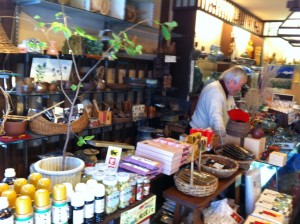
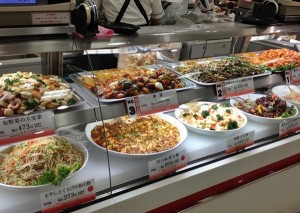

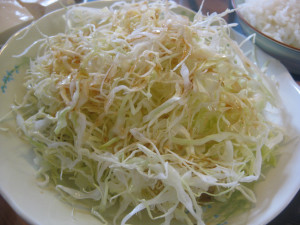
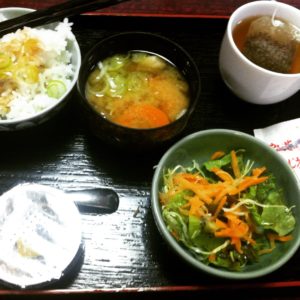


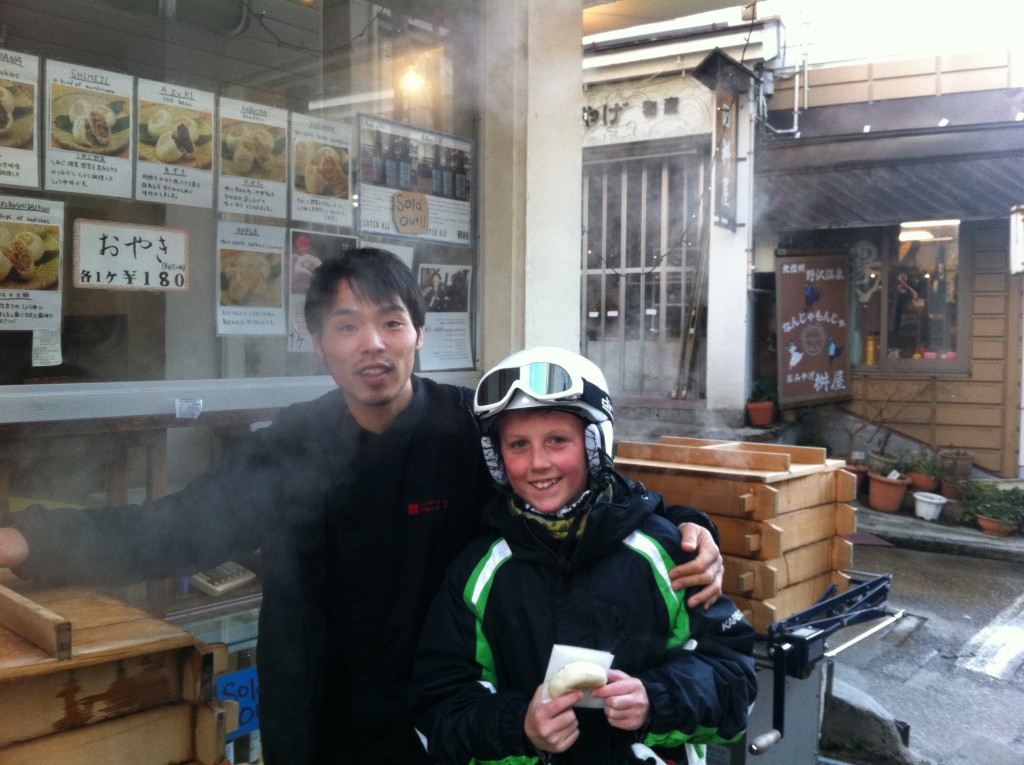

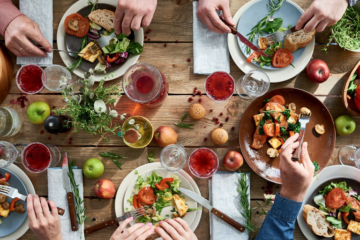
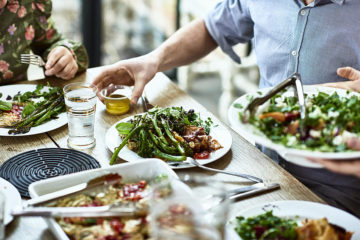

0 Comments